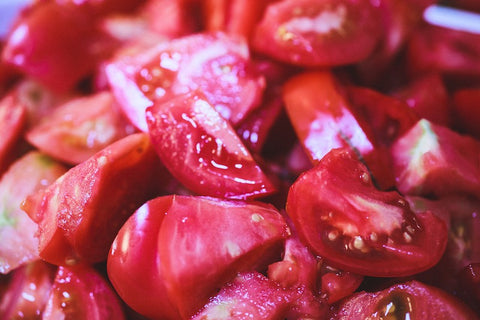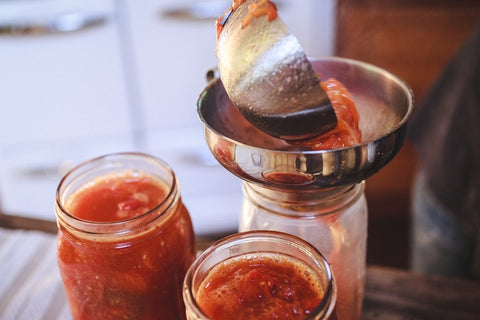- Continue Shopping
- Your Cart is Empty
7 Essential Tomato Canning Tips for Delicious Results

If you are not familiar with the water bath canning method watch our water bath canning video workshop. Always make sure you are following all safety guidelines outlined by the USDA when canning anything.
Not many things can bring back warm memories of summer like the taste of a great tomato. In fact, many of us spend the bulk of our gardening time coddling and caring for our tomato plants - researching the sweetest, most flavorful varieties, preparing our soil with special nutrients and tonics, pruning and tucking the tomato vines into their cages all summer long waiting for that first glimpse of red within the thick green vines.
You Don't Have to Settle for Mushy Out-of-Season Tomatoes

Tomatoes, like most fruits, are at their best when in-season and ripened in the sun. However, the truth is that tomatoes are only available this way for a very short summer season. One of my least favorite things is an out-of-season, warehouse-ripened tomato. Yuck! Not only do these tomatoes lack flavor, but they often have a mushy, spongy texture that is nothing like fresh summer tomatoes.
Preserving tomatoes is easy when you've got the right tools and ingredients. Tomatoes are mostly considered a high-acid food and can be canned using the water-bath canning method (when additional acid is added). To get the quickest fresh summer flavor, try canning your own tomato sauce, whole tomatoes, or crushed tomatoes.
To get the perfect flavor, texture and aesthetic when canning your next batch of fresh tomatoes, here are some tips, tricks and insights from my years of home canning experience. Read on to learn more...
Tomato Canning Tips

1) Select the Best Fruit
Choose only firm, ripe, disease-free fruits. Never use tomatoes from dead or frost damaged vines, which destroy their acidity. Plum, paste or dry-farmed varieties of tomatoes will produce a more concentrated tomato flavor product with less pre-cooking.
2) Ensure Proper Acidity
This is the most important factor in any home canning project, but is mostly a non-issue with pickles and jams because there is so much acid in those recipes to begin with. Tomatoes straddle the line in between high and low-acid. They have a high natural water content so you have to be extra careful to maintain an acidic enough environment to can them safely. Modern tomato canning recipes will call for bottled lemon juice or citric acid. It is very important to follow these recipes and add the proper amount of either.
3) Getting Processing Times Perfect
The processing time is the amount of time the canning jars are submerged under boiling water after they have been packed with food and the lids have been put on. Processing your jars ensures that all of the ingredients have been brought up to temperature, killing molds and yeasts and facilitating a proper seal of your lids. Tomatoes require a longer processing time than other high-acid foods because of their structure and water content. Certain “spoilers” can survive short processing times and, if they proliferate, can de-acidify your product to an unsafe level.
4) USDA Recommended Hot-Pack Processing Times
- Tomato juice
- 35 minutes for pints
- 40 minutes for quarts
- Crushed tomatoes
- 35 minutes for pints
- 45 minutes for quarts
- Tomato sauce
- 35 minutes for pints
- 40 minutes for quarts
- Ketchup
- 15 minutes for pints
- 20 minutes for quarts
Troubleshooting Common Issues
5) Avoiding Watery Sauce or Separation
The natural pectin in your tomatoes is what allows the sauce to thicken during cooking. Tomatoes contain an enzyme that, when exposed to air, begins to degrade the natural pectin. This can cause your jars of sauce to separate into layers of sauce and water. Working in small batches and choosing fresh tomatoes will help avoid this issue. Cooking your tomatoes with the skins and seeds will allow the tomato to release more of its natural pectin which will also help with this issue. Separation is just a visual problem, just shake your jar of sauce before you pour it and you will be A-OK.
 6) Avoiding Floating Tomatoes
6) Avoiding Floating Tomatoes
When canning whole tomatoes, a common complaint is a large amount of liquid at the bottom of your jar with “floating tomatoes” at the top after processing. The floating is caused by the tomatoes' natural water content, which gets released after you process them. Other than a visual disappointment to the person who labored over each jar, this creates no issue with your final product. While you cannot avoid floating tomatoes all together, pouring out some of the juices as you pack your jars can reduce this problem. Choosing fresh, firm tomatoes in the first place can help with floating issues. Packing tomatoes in a regular mouth jar is another solution. The opening of the jar is smaller so the tomatoes are naturally pushed downward. Want to eliminate this issue? Crush or quarter your tomatoes before packing. They most likely will end up in that state when you open and use the tomatoes later.
7) When to Remove Skin & Seeds
When making a puree or paste, cook down the tomatoes with their skins, seeds and cores before running them through the food mill. Cooking the tomatoes with the skin, seeds and core allows the pectin to be released during cooking and will save time.
Over to You...

It’s part of our mission here at Mountain Feed to help you make delicious, sustainable, homemade food, more often. Stop by and say hello on Facebook, Twitter, Instagram or Pinterest. Or, as always, you can do it the old fashioned way and come by the store to speak with one of our in-house experts.
If you are not familiar with the water bath canning method watch our water bath canning video workshop. Always make sure you are following all safety guidelines outlined by the USDA when canning anything. Keeping a great journal makes delicious results! Get inspired by new recipes, expert articles and homemade food adventures in our Monthly Journal.

 6) Avoiding Floating Tomatoes
6) Avoiding Floating Tomatoes